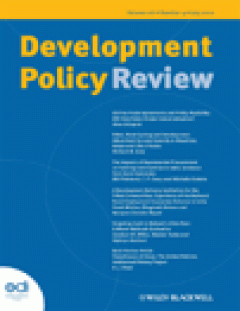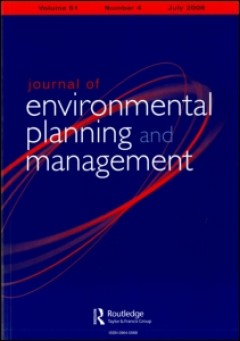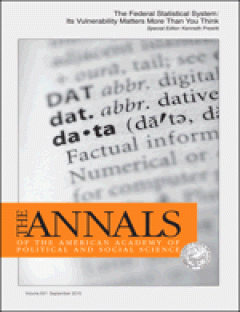Filter by

Stroke in Developing Countries: Epidemiology, Impact and Policy Implications
The burden of stroke and other non-communicable diseases has risen sharply in developing countries in recent years. This article provides a detailed review of this trend and its underlying causes, and discusses the social and economic effects of stroke and the scope for interventions to reduce incidence and mitigate impacts. It demonstrates that policy-makers have been slow to recognise the gro…
- Edition
- Volume 28, Issue 6, November 2010. pages 693–709
- ISBN/ISSN
- 09506764
- Collation
- -
- Series Title
- Development Policy Review
- Call Number
- -

Reducing Child Labour Through Conditional Cash Transfers: Evidence from Nicar…
Conditional Cash Transfer (CCT) programmes, providing eligible households with periodic cash payments, contingent on their children's adherence to school enrolment and attendance requirements, hold considerable promise for reducing levels of child labour across the developing world. This article presents the results of an analysis of a CCT programme in Nicaragua, Red de Protecci�n Social, and c…
- Edition
- Volume 28, Issue 6, November 2010. pages 711–732
- ISBN/ISSN
- 09506764
- Collation
- -
- Series Title
- Development Policy Review
- Call Number
- -

The Changing Pattern of Wage Returns to Education and its Implications
It is commonly believed that labour-market returns to education are highest for the primary level of education and lower for subsequent levels. Recent evidence reviewed in this article suggests that the pattern is changing. The causes of such changes, and their implications for both education and labour-market policy, are explored.
- Edition
- Volume 28, Issue 6, November 2010. pages 733–747
- ISBN/ISSN
- 09506764
- Collation
- -
- Series Title
- Development Policy Review
- Call Number
- -

Easy to Declare, Difficult to Implement: The Disconnect Between the Aspiratio…
The arguments in academia over the effectiveness of foreign aid fall into two broad categories: those grounded in political economy and those focused on donor conduct and aid effectiveness. There have been policy attempts within the donor community to reconcile them, including the 2005 Paris Declaration on Aid Effectiveness. This article examines the key features of foreign aid to Nigeria betwe…
- Edition
- Volume 28, Issue 6, November 2010. pages 749–770
- ISBN/ISSN
- 09506764
- Collation
- -
- Series Title
- Development Policy Review
- Call Number
- -

Factors affecting energy saving behaviour: a prospective research
The purpose of this study is to outline the theme of saving energy resources and its relationship with the preservation of the environment, as well as the importance of green marketing in achieving sustainability. The model of data collection was a survey conducted by self-administered questionnaire. After collection, the data were statistically analysed and interpreted. Most individuals claim …
- Edition
- Volume 53, Issue 8 December 2010 , pages 963 - 976
- ISBN/ISSN
- 09640568
- Collation
- -
- Series Title
- Journal of Environmental Planning and Management
- Call Number
- -

The importance of context for effective public engagement: learning from the …
This paper takes a new look at the importance of context - institutional and political - in effective public engagement processes. It does so through a rare comparative opportunity to examine the effectiveness of processes of public engagement in two UK waste authorities, where the same waste company was involved as both the primary contractor for the delivery of the waste management service (i…
- Edition
- Volume 53, Issue 8 December 2010 , pages 991 - 100
- ISBN/ISSN
- 09640568
- Collation
- -
- Series Title
- Journal of Environmental Planning and Management
- Call Number
- -

A multi-agent simulation model for spatial optimisation of manure allocation
- Edition
- Volume 53, Issue 8 December 2010 , pages 1011 - 10
- ISBN/ISSN
- 09640568
- Collation
- -
- Series Title
- Journal of Environmental Planning and Management
- Call Number
- -
- Edition
- Volume 53, Issue 8 December 2010 , pages 1011 - 10
- ISBN/ISSN
- 09640568
- Collation
- -
- Series Title
- Journal of Environmental Planning and Management
- Call Number
- -

Valuing lagoons using a meta-analytical approach: methodological and practica…
Lagoons are naturally complex ecosystems whose dynamics are strongly influenced by anthropic factors. Therefore, their value depends not only on their characteristics but also on the nature of the interactions, whether positive or negative, between mankind and nature. Starting from a representative set of 31 original studies exclusively devoted to coastal lagoons valuation, we estimate a meta-a…
- Edition
- Volume 53, Issue 8 December 2010 , pages 1031 - 10
- ISBN/ISSN
- 09640568
- Collation
- -
- Series Title
- Journal of Environmental Planning and Management
- Call Number
- -

The greening of Chicago: environmental leaders and organisational learning in…
Urban sustainability literature calls for new governance relations to support green urban agendas. Privileging non-hierarchical relations, this literature fails to address the means by which organisations create these capacities. The author interviewed public, private and community environmental leaders in metropolitan Chicago regarding their disposition toward creating boundary spanning organi…
- Edition
- Volume 53, Issue 8 December 2010 , pages 1051 - 10
- ISBN/ISSN
- 09640568
- Collation
- -
- Series Title
- Journal of Environmental Planning and Management
- Call Number
- -

An economic and environmental assessment of carbon capture and storage (CCS) …
In the not too distant future several power plants throughout Europe will have to be replaced and the decision has to be made whether to build coal-fired power plants with carbon capture and storage (CCS). In a study for the city of Kiel in northern Germany only an 800 MW coal power plant reaches a required minimum for rentability. This study looks at an additional economic and environmental ev…
- Edition
- Volume 53, Issue 8 December 2010 , pages 1069 - 10
- ISBN/ISSN
- 09640568
- Collation
- -
- Series Title
- Journal of Environmental Planning and Management
- Call Number
- -

Rule Following and Discretion at Government's Frontlines: Continuity and Chan…
As important players in the policy process, many studies have investigated the determinants of bureaucratic behavior. One intriguing set of findings suggests that behavior is linked to bureaucrats� views of themselves as government officials and their views of the people who they serve. Despite the importance of workers� perceptions, we have little understanding about how bureaucrats develop ps…
- Edition
- Vol. 20, No. 4, October 2010. pp. 735-755
- ISBN/ISSN
- 10531858
- Collation
- -
- Series Title
- Journal of Public Administration Research and Theory
- Call Number
- -

Working with the State: Exploring Interagency Collaboration within a Federali…
In an era of devolution, collaboration between state and local institutions could be an effective tool for state governments to capitalize on local knowledge and respect local autonomy, while maintaining consistent standards and enforcement. However, the benefits to local agencies are less clear. Local agency personnel may have goals that diverge from their state counterparts and significant co…
- Edition
- Vol. 20, No. 4, October 2010.pp. 757-778
- ISBN/ISSN
- 10531858
- Collation
- -
- Series Title
- Journal of Public Administration Research and Theory
- Call Number
- -

Customer, Partner, Principal: Local Government Perspectives on State Agency P…
Public agencies increasingly perform their functions in partnership with other public, nonprofit, and private sector actors, prompting growing research interest in how these collaborations function. As yet, almost no one has thought it worth asking how collaborative partners perceive each other's performance, although these perceptions may themselves constitute important measures of agency effe…
- Edition
- Vol. 20, No. 4, October 2010.pp. 779-799
- ISBN/ISSN
- 10531858
- Collation
- -
- Series Title
- Journal of Public Administration Research and Theory
- Call Number
- -

Personnel Flexibility and Red Tape in Public and Nonprofit Organizations: Dis…
Academics and journalists have depicted government bureaucracies as particularly subject to administrative constraints, including the infamous red tape and personnel rules that sharply constrain pay, promotion, and dismissal and weaken their relations to performance. Research on these topics has often focused on public organizations alone or on comparisons of public and private organizations. T…
- Edition
- Vol. 20, No. 4, October 2010. pp. 801-826
- ISBN/ISSN
- 10531858
- Collation
- -
- Series Title
- Journal of Public Administration Research and Theory
- Call Number
- -

Administrative Exclusion: Organizations and the Hidden Costs of Welfare Claiming
Organizations operate as the gateway to public benefits. They are formally authorized to adjudicate claims, in the process interpreting and applying eligibility rules. Beyond their designated role, they also operate as informal gatekeepers, developing modes of operation that affect the ease or difficulty of claiming. Operational practices�both formally prescribed and informally created�can add …
- Edition
- Vol. 20 No. 4, October 2010.pp. 827-848
- ISBN/ISSN
- 10531858
- Collation
- -
- Series Title
- Journal of Public Administration Reseach and Theory
- Call Number
- -

The Big Question for Performance Management: Why Do Managers Use Performance …
This article proposes that understanding public employee use of performance information is perhaps the most pressing challenge for scholarship on performance management. Governments have devoted extraordinary effort in creating performance data, wagering that it will be used to improve governance, but there is much we do not know about the factors associated with the use of that information. Th…
- Edition
- Vol. 20, No. 4, October 2010.pp. 849-866
- ISBN/ISSN
- 10531858
- Collation
- -
- Series Title
- Journal of Public Administration Research and Theory
- Call Number
- -

What Drives the Implementation of Diversity Management Programs? Evidence fro…
As the diversity of the US workforce continues to increase at a rapid pace, public managers are facing pressure to create organizational cultures that permit employees from different backgrounds to succeed. A typical managerial response to this diversity has been the implementation of a formal diversity management program. Although limited empirical research has considered links between diversi…
- Edition
- Vol. 20, No. 4, October 2010.pp. 867-886
- ISBN/ISSN
- 10531858
- Collation
- -
- Series Title
- Journal of Public Administration Research and Theory
- Call Number
- -

Science Starts Not after Measurement, but with Measurement
Federal statistics should be viewed and treated as part of the nation�s scientific infrastructure. The empirical social sciences dependent on those statistics produce social knowledge directly relevant to social problem analysis and policy formation. Statistics primarily come from the census and federal sample surveys, but increasing use is made of administrative and digital data. These two dat…
- Edition
- Vol. 631 no. 1, September 2010.pp. 7-16
- ISBN/ISSN
- 00027162
- Collation
- -
- Series Title
- The ANNALS of the American Academy of Political and Social Science
- Call Number
- -

Federal Statistics in the Policy making Process
Federal statistics are integral to the adequate evaluation of public policy planning and performance in the United States. The Obama administration has determined that empirical science, including statistics, will be at the foundation of the president�s policy agenda. However, to be useful, federal statistics must be reliable, relevant, timely, and unbiased, and the departments that produce the…
- Edition
- Vol. 631 no. 1, September 2010.pp. 34-42
- ISBN/ISSN
- 00027162
- Collation
- -
- Series Title
- The ANNALS of the American Academy of Political and Social Science
- Call Number
- -

The Government Accountability Office and Congressional Uses of Federal Statis…
This article examines the ways in which the U.S. Government Accountability Office (GAO) provides the U.S. Congress with information that is timely, objective, fact-based, nonpartisan, nonideological, fair, and balanced. It shows how over many decades, GAO�s work has led to laws that have improved government operations and saved the government and the taxpayers billions of dollars. The article r…
- Edition
- Vol. 631 no. 1, September 2010.pp. 43-62
- ISBN/ISSN
- 00027162
- Collation
- -
- Series Title
- The ANNALS of the American Academy of Political and Social Science
- Call Number
- -
 Computer Science, Information & General Works
Computer Science, Information & General Works  Philosophy & Psychology
Philosophy & Psychology  Religion
Religion  Social Sciences
Social Sciences  Language
Language  Pure Science
Pure Science  Applied Sciences
Applied Sciences  Art & Recreation
Art & Recreation  Literature
Literature  History & Geography
History & Geography